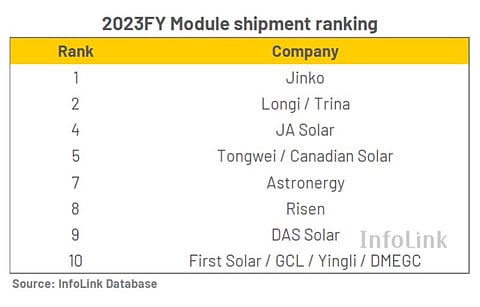

InfoLink Consulting's global solar cell and module shipment analysis for 2023 shows top Chinese manufacturers are keeping a stronghold over the supply chain, expanding the gap from tier II suppliers by a considerable margin. All the companies in its top 10 module suppliers list put together are expected to ship 700 GW in 2024, going by their shipment targets for this year.
Despite these massive plans, InfoLink forecasts annual solar module demand to slow down in 2024 with a mere 11% growth rate, ranging from 460 GW to 519 GW. It attributes this to the surplus supply in the global markets.
Analysts list module power output, quality and efficiency as the key factors that will determine the competitiveness of manufacturers this year.
China's JinkoSolar stayed put on the 1st place. While InfoLink does not offer any specific shipment volume, JinkoSolar had already shipped 52 GW in 9M/2023 (see Solid Financial Results For JinkoSolar In Q3/2023).
Trina has moved up on the list since H1/2023, now sharing the 2nd position with its compatriot LONGi, followed by JA Solar. Tongwei and Canadian Solar stand together on the 5th spot. Chinese manufacturers Astronergy, Risen Energy and DAS Solar take up the next 3 spots.
US' First Solar continues to be on the 10th position in InfoLink's top 10, but it is joined by Chinese manufacturers GCL, Yingli and DMEGC. Close shipment volumes during the year, pointing to fierce competition in this space, increased the total number of companies in the top 10 to 13.
Manufacturers whose total shipment does not differ by more than 5% are tied for the ranking, InfoLink explains.
All these companies together shipped 78% more annually in 2023, yet the quartet of JinkoSolar, LONGi, Trina and JA Solar retained their dominating positions as the top 4 on its list. They alone contributed around 60% of the total shipments last year showing greater consolidation.
Analysts opine, "Clearly, the biggest companies are getting bigger in recent years, leaving the second-ranked ones behind with significant shipment gap. The gap stood at 20 GW between leading companies and those ranked from the fifth in 2022, and then the gap widened to 30 GW in 2023 with 60 GW difference between the first fourth and the rest."
The average share of shipment to non-China markets in 2022 was around 50% to 55%. It dropped down to 40% to 45% in 2023 mainly due to weaker overseas channels for companies in the list, outside of the top 4, as they focused on domestic demand.
Nonetheless, InfoLink forecasts a massive increase in total solar module shipments of the 13 companies in its top 10 list, reaching 700 GW, including 70% coming from new technology products. Top 4 producers target to ship over 90 GW to 120 GW, again increasing the gap from 2nd ranked manufacturers.
Manufacturers should watch out for policy changes and conditions on materials use and product of origin to protect themselves from severe competition in the future.
Among solar cell suppliers, it is the Chinese giant Tongwei Solar that has retained its top spot as the largest solar cell supplier in 2023. Together with Aiko, SolarSpace, Jeitai and Runergy, the top 5 cell suppliers shipped a combined 182 GW last year, with a 56% annual increase.
The shipments of this quintet were dominated by 133 GW of pan-182 mm cells and 43 GW of pan-210 mm cells. InfoLink says this indicates a 97% market share of large-format cells. M6 and smaller sizes are fast becoming obsolete as manufacturers shut these lines.
The top 5 adopted the rectangular format of 182 mm for PERC production, mostly opting for 183 mm. For n-type cells, shipments of 183 mm and 191 mm cells are reported to have begun in H2/2023.
Even though the market is moving fast towards TOPCon cells, PERC remained the major driving force with manufacturers shipping 146 GW of the latter. TOPCon sales picked up pace in H2, reaching 35 GW. Heterojunction (HJT) and back-contact cells were mostly for in-house production. India and Turkey were among the non-Chinese nations where most of the multi-Si modules ended up.
InfoLink points out that high-efficiency products are more profitable, but the boom-and-bust scenario of 2023—a price rise in H1 followed by an oversupply in H2—left cell manufacturers with a gross margin of -11%. Some even had to shut down production to cut losses.
